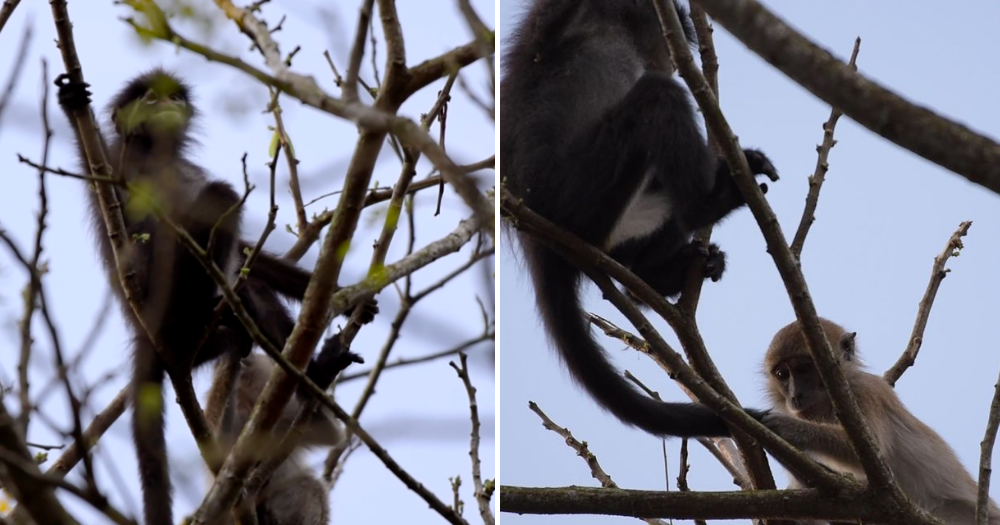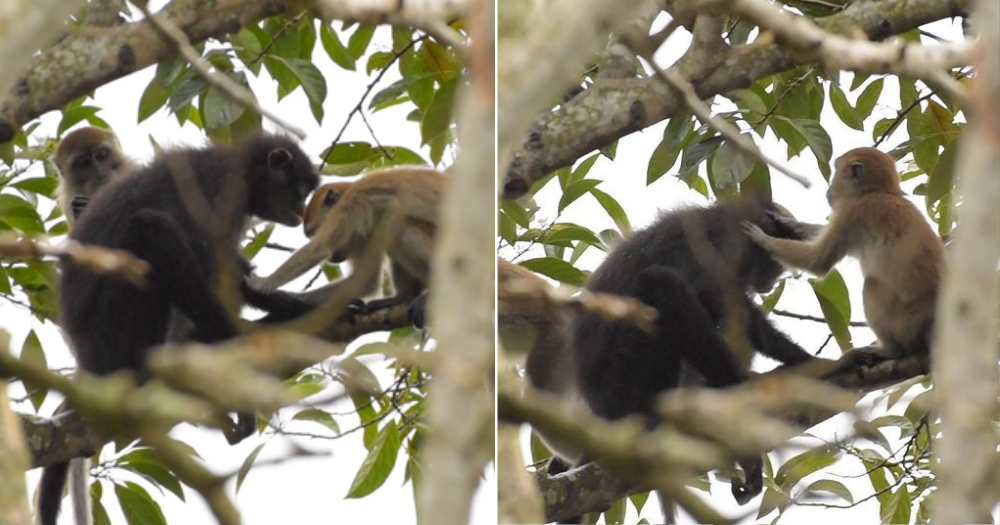Follow us on Telegram for the latest updates: https://t.me/mothershipsg
On two separate occasions in October 2020, researchers observed Long-tailed macaques grooming critically endangered Raffles’ banded langurs for the first time.
The sightings were conducted at the Gunung Lambak Recreational Forest in Kluang, Malaysia, and the findings were published on August 26.
First observation
On October 2, 2020, two subadult male Long-tailed macaques approached an adult female Raffles’ banded langur and groomed her.
This female langur was a lactating mother who had a dependent infant.
While one macaque moved away after half a minute, the other groomed the langur for a total of eight minutes, picking substances from the langur's fur and feeding on it.
They were interrupted by an alpha langur male, and the two species separated soon after.
Second observation
On October 8, 2020, a female subadult Long-tailed macaque was actively seeking Raffles’ banded langurs to groom while the langurs were foraging.
She started by touching a langur's tail from a distance with an extended hand, and if they stayed in position, she would get closer to inspect while presenting her body in front of the langur.
The macaque was rejected by several langurs, who moved away from their positions.
 Photo via Lee, Z.H., Ang, A. and Ruppert, N..
Photo via Lee, Z.H., Ang, A. and Ruppert, N..
The macaque managed to groom at least two juvenile females and two adult females.
She was seen extracting substances from langur's fur by hand-picking and feeding on it as well as directly biting the langur's fur with her mouth.
Similar to the first observation, no direct confrontation or aggressive behaviour was observed. However, this time, some of the langurs appeared impatient towards the groomer and prioritised feeding.
Interspecies grooming
Social grooming is a key behaviour in primates that facilitates hygiene while playing a significant role in reinforcing social bonds and networks.
According to the authors of the study, interspecies grooming between the Raffles' banded langur and other primate species has not been reported before.
Studies about interspecies grooming are often conducted on animals in captivity, and there are only a handful of publications addressing interspecies grooming occurring in the wild.
While such behaviour has been anecdotally recorded in the field between more closely related primates species, there are virtually no published research about grooming involving primate species belonging to different genera.
Why did this happen?
In both observations, Long-tailed macaques of both sexes were the ones grooming the langurs.
Given that adult Raffles' banded langurs are about two times the size of young Long-tailed macaques, the authors suggest that the macaques likely groomed for rank-related benefits and as a form of stress relief.
In the first instance, conflict within the macaques was observed just before the grooming event.
The macaques might have groomed the langur as a form of post-conflict consolation, where the victims of aggression may seek out bystanders to the aggression to groom for comfort.
It also cannot be ruled out that the macaques groomed in search of food, and the langurs were willing to be groomed for hygiene purposes.
According to the authors, it is also likely that the Long-tailed macaques were more willing to engage in interspecies interactions because they have been regularly fed by humans.
They believe that this behaviour is more common than it is reported in the wild.
Fewer than 400 individuals worldwide
The authors also raised concerns that such interspecies interactions may facilitate the transmission of zoonotic diseases, adding to the factors that already threaten the rare Raffles' banded langurs.
Critically endangered, the Raffles’ banded langur is only found in southern Peninsular Malaysia in the states of Johor and Pahang, as well as Singapore.
With an estimated global population size of fewer than 400 individuals, Singapore is home to about 60 to 70 individuals.
Follow and listen to our podcast here
Top images via Lee, Z.H., Ang, A. and Ruppert, N..
If you like what you read, follow us on Facebook, Instagram, Twitter and Telegram to get the latest updates.
